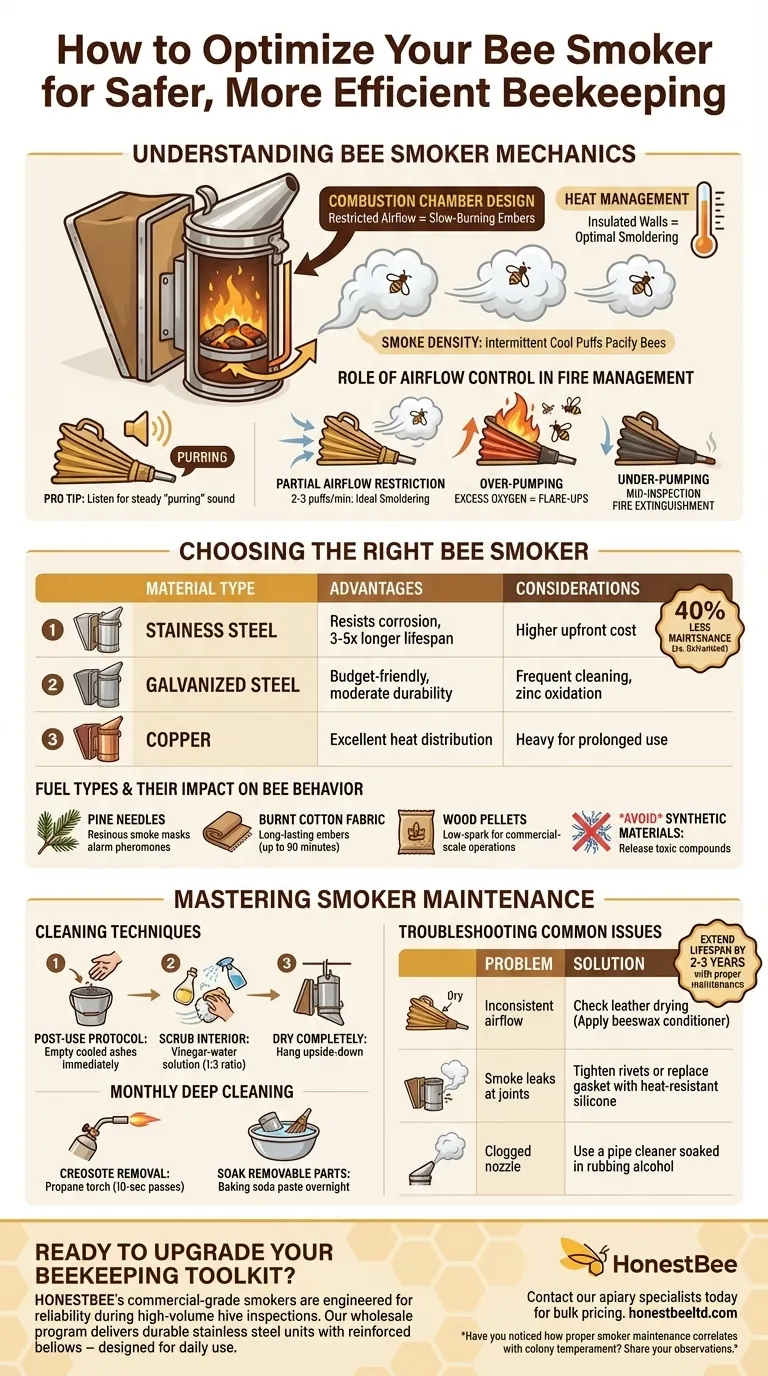A well-maintained bee smoker is the cornerstone of productive hive inspections. This guide unpacks material selection, fuel efficiency, and maintenance practices to help beekeepers achieve consistent smoke output while extending equipment lifespan.
Understanding Bee Smoker Mechanics
Design Principles for Sustained Smoke Output
Bee smokers function by creating cool, thick smoke that pacifies bees without harming them. The key lies in:
- Combustion chamber design: Cylindrical shapes with restricted airflow promote slow-burning embers
- Heat management: Insulated walls prevent overheating while maintaining optimal smoldering temperatures
- Smoke density: Research shows bees respond best to intermittent, cool smoke puffs rather than continuous streams
Role of Airflow Control in Fire Management
The bellows system dictates smoke consistency:
- Partial airflow restriction creates ideal smoldering conditions (approximately 2-3 puffs per minute)
- Over-pumping generates excess oxygen, leading to flare-ups that may agitate bees
- Under-pumping risks fire extinguishment mid-inspection
Pro Tip: Listen for a steady "purring" sound from the smoker – this indicates balanced airflow.
Choosing the Right Bee Smoker
Material Considerations for Durability and Safety
| Material Type | Advantages | Considerations |
|---|---|---|
| Stainless Steel | Resists corrosion, 3-5x longer lifespan | Higher upfront cost |
| Galvanized Steel | Budget-friendly, moderate durability | Requires frequent cleaning to prevent zinc oxidation |
| Copper | Excellent heat distribution | Heavy for prolonged use |
Field tests show stainless steel smokers require 40% less maintenance over a typical beekeeping season compared to galvanized models.
Fuel Types and Their Impact on Bee Behavior
Best Performing Fuels:
- Pine needles: Produce resinous smoke that masks alarm pheromones effectively
- Burnt cotton fabric: Creates long-lasting embers (up to 90 minutes)
- Wood pellets: Low-spark option for commercial-scale operations
Avoid synthetic materials – they can release toxic compounds that contaminate honey.
Mastering Smoker Maintenance
Cleaning Techniques to Prevent Corrosion
-
Post-use protocol:
- Empty cooled ashes immediately
- Scrub interior with a vinegar-water solution (1:3 ratio)
- Hang upside-down to dry completely
-
Monthly deep cleaning:
- Remove creosote buildup using a propane torch (10-second passes)
- Soak removable parts overnight in baking soda paste
Troubleshooting Common Bellows and Nozzle Issues
Problem | Solution ---------|------------
Inconsistent airflow | Check for leather drying (apply beeswax conditioner)
Smoke leaks at joints | Tighten rivets or replace gasket with heat-resistant silicone
Clogged nozzle | Use a pipe cleaner soaked in rubbing alcohol
Beekeepers report these maintenance practices can extend smoker lifespan by 2-3 years compared to neglected equipment.
Ready to Upgrade Your Beekeeping Toolkit?
HONESTBEE's commercial-grade smokers are engineered for beekeepers who demand reliability during high-volume hive inspections. Our wholesale program delivers durable stainless steel units with reinforced bellows – designed to withstand daily use while maintaining perfect smoke consistency. [Contact our apiary specialists] today for bulk pricing on equipment that keeps your bees calm and your operations smooth.
Have you noticed how proper smoker maintenance correlates with colony temperament during inspections? Share your observations with fellow beekeepers in the comments.
Visual Guide

Related Products
- Premium Traditional Copper Bee Smoker with Bellows
- Stainless Steel Honey Bee Smoker Hive and Honeycomb Smoker for Beekeeping
- Economy Galvanized Beekeeping Honey Bee Smoker for Wholesale
- Heavy Duty Manual Bee Smoker Blower for Beekeeping
- European Stainless Steel Bee Smoker for Honey Bee Hive
Related Articles
- How to Use a Bee Smoker Effectively: Protecting Colonies and Beekeepers
- How to Choose and Prepare Optimal Bee Smoker Fuels for Healthier Hives
- How to Master Your Beekeeping Smoker: Safe Operation & Optimal Fuel Choices
- Mastering the Use of Beekeeping Smokers
- The Signal and the Noise: The Art of Speaking to Bees with Smoke




















